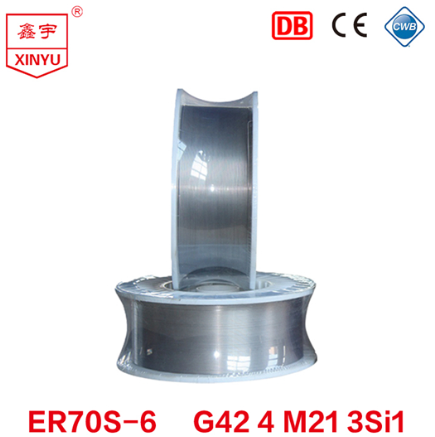Tips for Choosing A Solid Wire for Welding Applications
- 21 ago, 2022
- 4431 visitas

No two welding operations are the same. Yet in many cases, companies come to rely on similar filler metals to get the job done. Solid wire is among the most widely used filler metals in the industry and is a common choice for applications ranging from general fabrication and manufacturing to maintenance/repair and pipeline welding. The wire’s ease of use contributes to its popularity, as does its ability to weld many types and thicknesses of materials. Welding technology available on the market today also makes it easier for welding operators of varying skill sets to create quality welds with solid wire.
As with any type of filler metal, there are several considerations to keep in mind when choosing a specific solid wire for an application. Different classifications offer varying characteristics for each solid wire, all of which can impact weld strength and quality, as well as the amount of post-weld cleanup needed.
Solid wire: An overview
The American Welding Society (AWS) provides multiple classifications for solid wire based on the mechanical and chemical properties each provides. Each letter and number in its nomenclature signifies a specific feature. As an example, for a commonly used solid wire — AWS ER70S-6 — the “ER” indicates that the filler metal is an electrode or rod; the “70” signifies that it has a tensile strength of 70,000 pounds per square inch (psi), and the “S” means that it is a solid wire. The 6 reflects the chemical composition and shielding gas requirements.
Solid wires that end in S-3 and S-6 are among the most commonly used in the industry for MIG welding. For TIG welding applications, an ER70S-2 cut-length (or rod) is often used. Solid wires are available in a range of diameters. For MIG welding applications, diameters range from 0.023 up to 1/16 inch, whereas solid wires used in submerged arc welding (SAW) processes can be up to 1/8 inch and larger. TIG cut-lengths are available in diameters of 1/16 to 5/32 inches. Typical operating parameters for solid wire depend upon these diameters and in a MIG or SAW process, also on wire-feed speed. The wire feed speed is proportional to the amperage used for the welding application. Voltage can range from 14 volts to more than 30 volts.
When using solid wires, spray transfer and short-circuit transfer are two common welding modes. The transfer mode used for an application depends on the shielding gas and the welding parameters. Achieve spray transfer mode requires a minimum of 85 percent argon in the shielding gas mixture. The result of this mixture is less undercutting and a more fluid, controllable puddle. The preferred gas for short-circuiting transfer mode is 75 percent argon/25 percent CO2, which provides good arc transfer, lower levels of spatter, and a nice appearance of the completed weld bead.
4 Tips To Help Choose Welding Wire
ㆍIdentify your metals. Even though various metals can be used in MIG welding, the three most common are carbon steel, stainless steel, and aluminum. These base metals, as they are called, influence the composition and thickness required of the welding wire.
ㆍMatch your wire. Ideally, the welding wire will be the same type of metal as the metal that is going to be welded. Stainless steel metals should be used with stainless steel wires, carbon steel with carbon steel wires, etc. Keep this in mind and refer to the wire’s primary metal when choosing welding wire.
ㆍThere’s no need to avoid mixed metals in favor of pure metals. It’s not unusual for MIG wires to include additional elements along with the metal. Elements like manganese, silicon, and titanium are often added to wires to make the welds stronger, more stable, less porous, or prone to oxidation. It’s perfectly ok, and sometimes preferable, to choose a wire that has these additional elements in it.
ㆍPay attention to thickness. The thickness of the base metals determines the thickness of the wire you’ll use. Check the wire thickness charts on wire product packaging to help guide your decision. Keep in mind that there’s a range of thicknesses that will work for standard wire diameters, so you don’t need to know the exact gauge of the plates being welded.
ER70S-6 solid wires
An ER70S-6 solid wire is the most common choice for welding mild steel. This widely available wire is found in general fabrication, and automotive welding applications and can be used for robotic welding, as well as to complete root passes for pipe welding and other critical or industrial applications. It offers smooth and consistent wire feeding, which helps support greater productivity (there is less downtime to address feeding issues), and the wire helps to increase consumable life. With the proper use, it creates smooth weld beads with a uniform tie-in.
Welding operators can use ER70S-6 solid wire with 100 percent CO2 to increase joint penetration or with an argon/CO2 blend to help minimize spatter. They should also be aware that these wires tend to generate silicon island deposits on the surface of the completed weld. They will need to remove these deposits prior to painting or other types of surface conditioning, which may increase the time for post-weld cleaning.
While solid wires generally generate low spatter levels on clean base materials, they may not be the best option for welding contaminated metals. If, however, there is no alternative, an ER70S-6 wire may be helpful for welding through light rust or mill scale. This wire contains higher silicon and manganese content, which act as excellent deoxidizers.
Xinyu provides various welding wires including ER70S-6 solid wires. If you are interested in our products, please contact us now!
- Categoría:
- Negocio
- Sin comentarios


